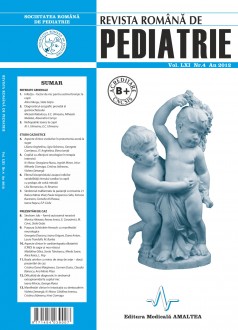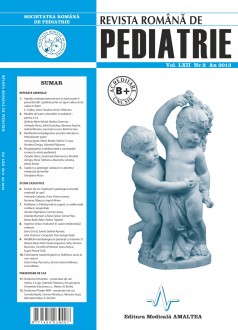SELECT ISSUE

Indexed

| |

|
|
|
| |
|
|
|

|
|
|
|
|
|
|
HIGHLIGHTS
National Awards “Science and Research”
NEW! RJP has announced the annually National Award for "Science and Research" for the best scientific articles published throughout the year in the official journal.
Read the Recommendations for the Conduct, Reporting, Editing, and Publication of Scholarly work in Medical Journals.
The published medical research literature is a global public good. Medical journal editors have a social responsibility to promote global health by publishing, whenever possible, research that furthers health worldwide.
Malformative syndrome in patients with trisomy 21
Raluca Maria Vlad, Paula Grigorescu Sido, Simona Bucerzan, Camelia Al-Khzouz, Ioana Naşcu and Eugen Pascal Ciofu
ABSTRACT
Background and aims. Trisomy 21 is the most frequent autosomal chromosomopathy. The clinical picture includes dysmorphism, developmental delay and malformative syndrome. At present time, in Romania, the cytogenetic diagnosis is delayed. The aim of this study was to evaluate the current malformative syndrome and to correlate its elemets and the cytogenetic features.
Material and method. We conducted an observational study that included 136 patients with trisomy 21 recruited from the Department of Medical Genetics, Emergency Children’s Hospital, Cluj-Napoca and the Department of Pediatrics, “Grigore Alexandrescu” Emergency Children’s Hospital, Bucharest. The patients were evaluated recording the associated congenital malformations.
Results. In 91.2% of the cases the diagnosis of regular trisomy 21 was established. The cariogram was performed late, at a mean age of 1 year 6 months. 94.1% associated at least one congenital malformation, 36.8% having four or more. In descending order of the frequency, the following malformations were described: osteo-articular, cutaneous, cardiac, of male genitalia, digestive, reno-urinary, muscular, ocular, respiratory and of the thyroid in: 86%; 66.2%; 52.2%; 21.7%; 18.4%; 8.1%; 8.1%; 7.4%; 2.9% and 1.5% respectively. No significant differences were found between regular and mosaic trisomy 21.
Conclusions. The clinical picture of trisomy 21 is going through some changes lately, regarding the malformative syndrome, the prevalence we communicate for some of the specific congenital malformations is lower; in 5.9% of the cases no congenital malformations were associated. No significant differences were found in relation to the cytogenetic diagnosis.
Key words: trisomy 21, malformative syndrome

